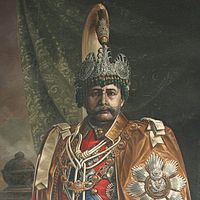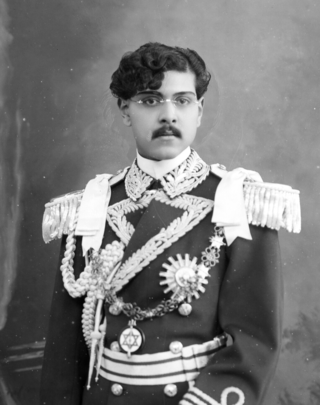
Tribhuvan Bir Bikram Shah was King of Nepal from 11 December 1911 until his death. Born in Kathmandu, the capital city of Nepal, he ascended to the throne at the age of five, upon the death of his father, Prithvi Bir Bikram Shah, and was crowned on 20 February 1913 at the Nasal Chowk, Hanuman Dhoka Palace in Kathmandu, with his mother acting as regent. At the time of his crowning, the position of monarch was largely ceremonial, with the real governing power residing with the Rana family.

The Nepali Congress is the largest social democratic political party in Nepal. As per the results of recent local election, Nepali Congress stands as the single largest party of Nepal at all levels of government. It is the current main opposition party in Nepal since 26 December 2022. With more than one million active members, the party remains the largest party in Nepal by membership.
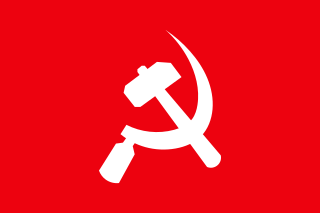
The Communist Party of Nepal, abbreviated CPN, was a communist party in Nepal from 1949 to 1962. It was founded on 15 September 1949 to struggle against the autocratic Rana regime, feudalism, and imperialism. The founding general secretary was Pushpa Lal Shrestha. The founding members of the Communist Party of Nepal were Moti Devi Shrestha, Niranjan Govinda Vaidya, Nar Bahadur Karmacharya and Narayan Bilas Joshi.
Nepal Rashtrabadi Gorkha Parishad, a pro-monarchy political party in Nepal. The party was founded in 1951 by members of the erstwhile Rana dynasty. The party was led by Bharat Shamsher JBR and MG Mrigendra Shamsher JBR.
Samyukta Prajatantra PartyNepal was a political party in Nepal. The party was led by Kunwar Inderjit Singh.
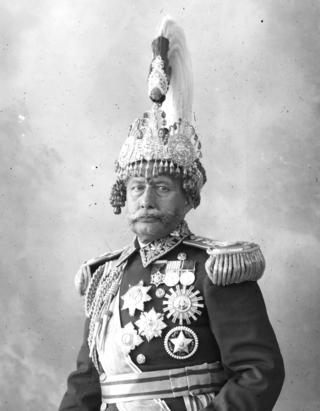
Field-Marshal Shree Shree Shree Maharaja Sir Mohan Shumsher Jung Bahadur Rana, GCB, GCIE, GBE was the prime minister and foreign minister of Nepal from 30 April 1948 until 12 November 1951.
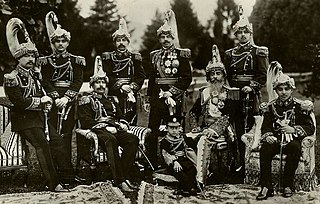
Rana dynasty was a Chhetri dynasty that imposed totalitarianism in the Kingdom of Nepal from 1846 until 1951, reducing the Shah monarch to a figurehead and making Prime Minister and other government positions held by the Ranas hereditary. They claimed Kshatriya status themselves. Rana dynasty is historically known for the iron-fisted rule. This changed after the Revolution of 1951 with the promulgation of a new constitution, when power shifted back to the monarchy of King Tribhuvan.

The Rastrapati Bhawan is the official residence of the President of Nepal, located in Kathmandu, Nepal. It hosts the Office of The President of Nepal. The main palace building was and still is known as Sital Niwas. It was built by Rana Prime Minister Chandra Shumsher JBR in 1923.

Subarna Shamsher Rana was a leading figure in the movement to overthrow the ruling Rana oligarchy and to establish democracy in Nepal. He was one of the three leaders of the Nepali Congress in the late 1940s, opposing his relatives, the Rana family, who held power in Nepal at the time.
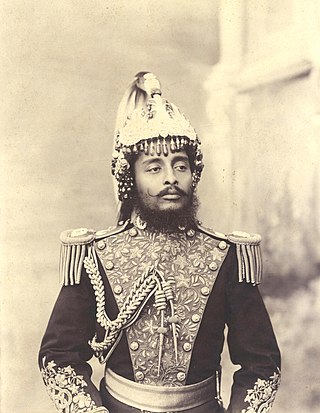
Field-Marshal Maharaja Sri Teen Chandra Shumsher Jung Bahadur Rana was the Prime Minister of Nepal from the Rana dynasty. He served in this capacity from 27 June 1901 to his death in 1929, after he successfully deposed his liberal and reformist brother Dev Shamsher. Although generally perceived as despotic and conservative, he is credited with several reforms including the abolition of slavery and the Nepal-Britain Treaty of 1923, which recognized Nepal as an independent nation and an ally of Britain.
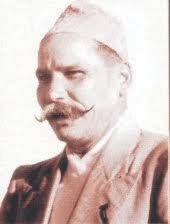
Kunwar Indrajit Singh, popularly known as Dr. K.I. Singh or just K.I. Singh was a Nepali politician and revolutionary who served as the 20th Prime Minister of Nepal in 1957. He was key Nepali Congress in organizing the 1951 Nepali Revolution, and was a leader in its militant wing, the Muktisena, who later refused to recognize the Delhi Accord and was forced to flee the country following a revolt he took part in. In 1955 he returned and formed the United Democratic Party, and following the installation of the Panchayat system he agitated for its end, for which he was jailed. Following his release, he went into self-imposed exile, and much later returned to Nepal and was elected a member to the Rastriya Panchayat. He was known as the "Robin Hood of the Himalayas", and was very popular throughout the country.

Tanka Prasad Acharya was a Nepali politician who served as the 19th Prime Minister of Nepal from 1956 to 1957. He was one of the founders and the leader of the Nepal Praja Parishad, the first political party in Nepal with the goal of removing the Rana Dynasty's dictatorship.

The Nepal Praja Parishad was the first attempt to form an organization to lead the revolution against the Rana dynasty in Nepal. Led by Tanka Prasad Acharya, the group was founded in 1936, and is seen as the first political party in Nepal. The organisation collapsed after their plot to assassinate multiple members of the Rana regime was discovered, and some of its key members were executed.

The revolution of 1951 in Nepal, also referred to as Sat Salko Kranti, was a political movement against the direct rule by the Rana dynasty of Nepal which had lasted for 104 years. It marks the beginning of the political awakening and democratic movements in Nepal, and resulted in immediate abolition of the institutionalized hereditary Prime Minister system in Nepal.

The Jayatu Sanskritam movement begin in 1947 AD(BS 2004), started by students of the Tin Dhara Pakshala Sanskrit School in Nepal. They demanded democracy, basic welfare, and the inclusion of modern subjects in their curriculum. It was the first student uprising in Nepal's history, and led to the Revolution of 1951 and the fall of the Rana dynasty.
Delhi Accord was a tripartite agreement (verbal) in Delhi after mutual agreement between Ranas, Nepali congress party and King Tribhuban.
Lakshmi Niwas is a Rana palace in Maharajgunj, Kathmandu, the capital of Nepal. The palace complex, located north of the Bagmati river, was incorporated in an impressive and vast array of courtyards, gardens and buildings. It was built by Chandra Shumsher JBR, at the time prime minister and the executive leader of Nepal.

Matrika Prasad Koirala formed the first government of Nepal by a commoner after he was appointed as the prime minister by King Tribhuvan. The government was formed after the previous government under Mohan SJB Rana fell after Nepali Congress ministers resigned. King Tribhuvan made a royal proclamation on 16 November 1951 and invited Matrika Prasad Koirala from the Nepali Congress to form the government.

Matrika Prasad Koirala formed his second government in 1953 after his appointment by King Tribhuvan. The cabinet was expanded in February 1954 to include Nepal National Congress, Nepal Praja Parishad and Nepali Jan Congress.

Tanka Prasad Acharya formed a government on 27 January 1956 after being appointed as prime minister by King Mahendra. The cabinet was expanded in February 1957 to add more deputy ministers.

